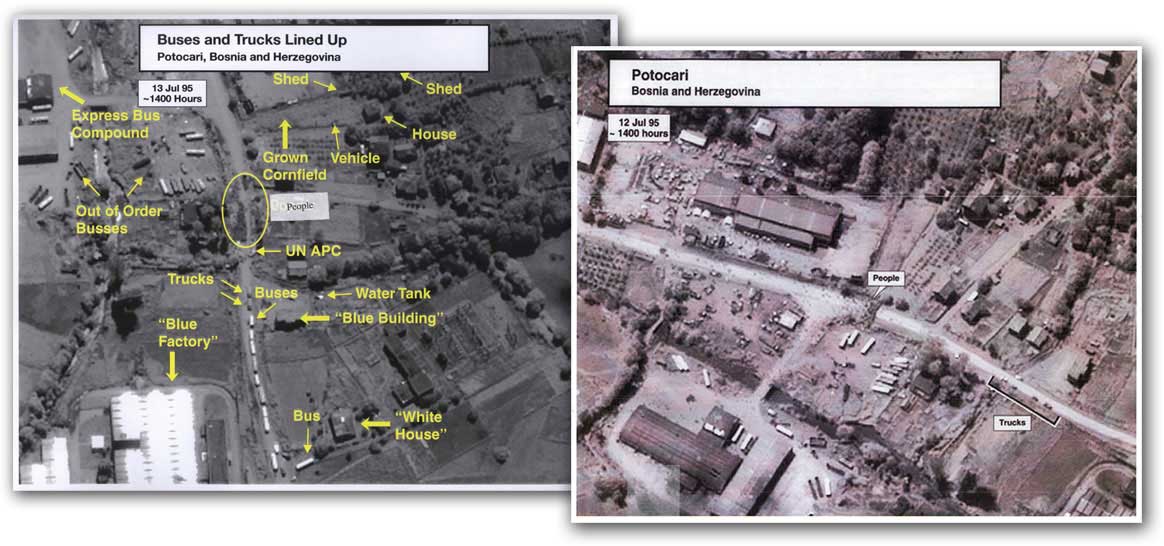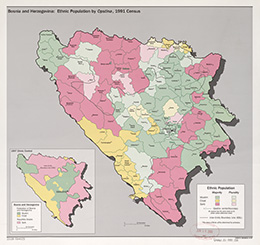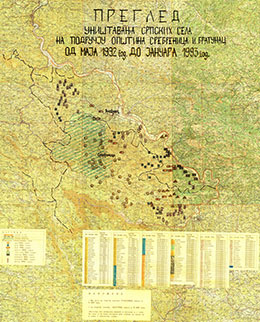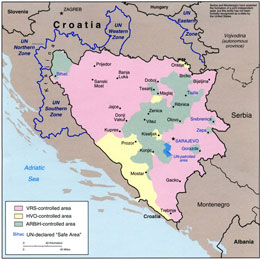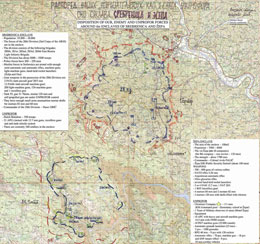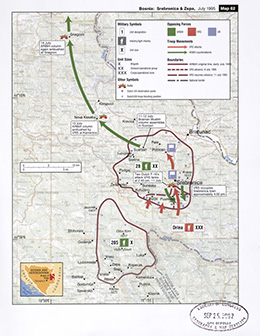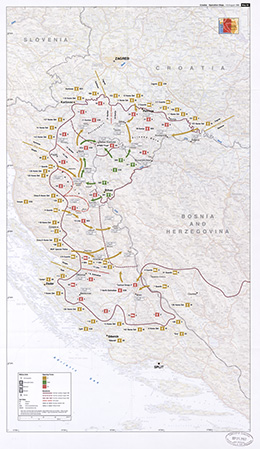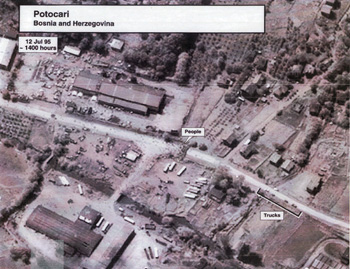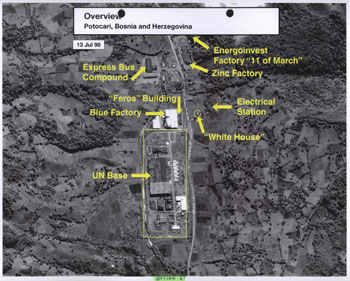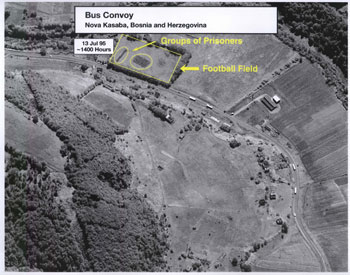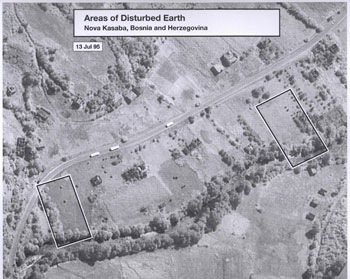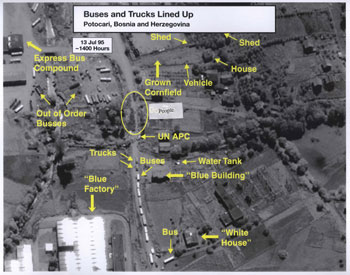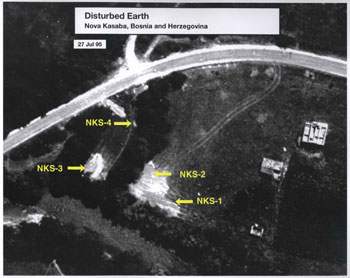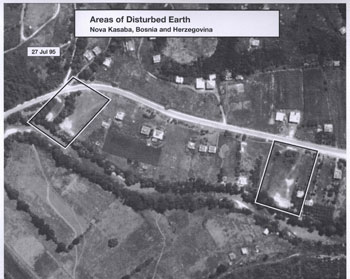The Srebrenica ConferenceInternational Decision-Making in the Age of Genocide: Srebrenica 1993-1995 Lessons from Srebrenica: 20 Years Later Video: Srebrenica 20 Years Later International Conference Examines Failure to Prevent Genocide in Srebrenica Results from Rwanda Conference In the NewsDeclassified U.N. Cables Reveal Turning Point in Rwanda Crisis of 1994 Genocide Under Our Watch Exclusive: Rwanda Revisited Previous PostingsSrebrenica conference documents detail path to genocide from 1993 to 1995. Key Decision Makers and Eyewitnesses Gather in the Hague to Consider the Failure of the International Community in the 1994 Rwandan Genocide "International Decision-Making in the Age of Genocide: Rwanda 1991-1994" The Secret History of Dayton: U.S. Diplomacy and the Bosnia Peace Process 1995 Lessons Learned from U.S. Humanitarian Interventions Abroad |
Mladic with his Bosnian Serb Army in Srebrenica on July 12, 1995 - Source: Getty Images Bosnian Serb Army of Mladic in Srebrenica, July 12, 1995 - Source: Getty Images. Expulsion of Muslims in Srebrenica, Bosnia July 12, 1995 - Source: Getty Images. Refugees from Srebrenica in UN Camp near Tuzla in Bosnia July 17, 1995 - Source: Getty Images. Expulsion of Muslims in Srebrenica July 12, 1995 - Source: Getty Images. Bosnian Serb Army of Mladic in Srebrenica – July 12, 1995 - Source: Getty Images. 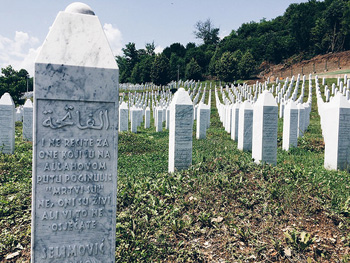 Grave markers at the Srebrenica-Potocari Memorial and Cemetery for the Victims of the 1995 Genocide – Source: Sarah Reichenbach, The Advocacy Project, June 2015 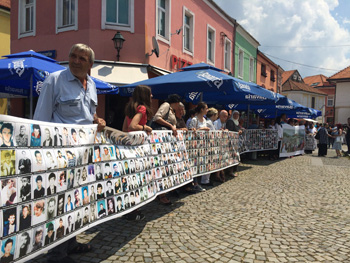 Loved ones remember those killed in the Srebrenica Massacre during a monthly memorial demonstration in Tuzla, Bosnia, June 11, 2015 – Source: Sarah Reichenbach, The Advocacy Project 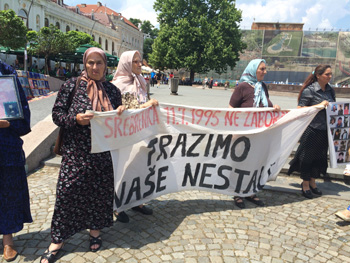 Loved ones remember those killed in the Srebrenica Massacre during a monthly memorial demonstration in Tuzla, Bosnia, June 11, 2015 – Source: Sarah Reichenbach, The Advocacy Project  Case files at The International Commission on Missing Persons (ICMP) in Tuzla, Bosnia – Source: Sarah Reichenbach, The Advocacy Project, June 2015 Washington, D.C., November 23, 2015 – Lack of reaction by United Nations forces in the former Yugoslavia to escalating Bosnian Serb offensives in June and July 1995 played a crucial role in the eventual decision by Bosnian Serb general Ratko Mladic to murder more than 7,000 Muslim refugees, Bosniak men and boys of Srebrenica, 20 years ago, according to documents posted today by the National Security Archive (https://nsarchive2.gwu.edu). The documents show the Srebrenica genocide represented a debacle for international peacekeeping and a turning point towards more forceful intervention, culminating in the Dayton accords that ended the Balkan wars on November 21, 1995. The documents published today formed part of the briefing book compiled by the Archive for the historic “critical oral history” conference in The Hague this past June on the 20th anniversary of the Srebrenica genocide. The U.S. Holocaust Memorial Museum and The Hague Institute for Global Justice co-organized the conference with the Archive’s support, and this week are publishing the conference transcript and rapporteur’s summary to mark the 20th anniversary of the Dayton agreement. The documents detail what prosecutors at the Mladic trial before the International Criminal Tribunal on the former Yugoslavia have argued was a rolling decision by Mladic, whose orders on July 2, 1995, only contemplated “squeezing” the U.N. peacekeepers and population of Srebrenica, already full of Muslim refugees from prior ethnic cleansing by Serb forces. Meeting almost no resistance by July 9, the documents show, the Bosnian Serbs decided to overrun the so-called “safe area” despite a series of U.N. Security Council mandates ostensibly placing Srebrenica under international protection. Having swept aside the desperately under-supplied Dutch peacekeepers, the Bosnian Serbs forced the remaining Bosniak military into retreating columns fleeing through the hills, and captured tens of thousands of refugees. Only then – according to court documents – did Mladic decide to separate the men and boys for what he called “screening for war crimes” and ultimately mass execution. The documents detail a pattern of senior U.N. leaders refusing to confront Bosnian Serb aggression, insisting on impartiality between the parties, and coming back time after time for permission to get aid convoys through and for negotiations to set up more ceasefires that were sure to be broken. This pattern of passivity started from the very beginning of the U.N. Security Council mandates in 1993 to protect Srebrenica and the other so-called “safe areas” – Bosniak enclaves deep in Serb-held territory – when the U.N. and its member states failed to provide either the troops or the arms that would have been necessary to impose a peace where there was none to keep. The documents show that U.N. leaders – especially the Secretary General’s Special Representative, Yasushi Akashi, and his top generals, Bertrand De La Presle and (at the time of Srebrenica) Bernard Janvier – resisted using air strikes for deterrence or compellence against the Serbs for more than a year prior to Srebrenica, and restricted air power to limited strikes even when peacekeepers were under direct attack. Divisions within the Clinton administration and between the U.S. and key allies such as Britain and France over the use of force also enabled the U.N.’s inaction. The cycle of limited U.N./NATO strikes followed by Bosnian Serb hostage-taking of U.N. personnel to serve as human shields, followed by negotiations and de-escalation, had apparently taught the Serbs to probe, fall back if struck from the air, but press forward when response was lacking. Even after the U.N. had recovered the most recent group of U.N. hostages on June 18, 1995, General Janvier reiterated his insistence on avoiding confrontation at all costs. The documents show that U.N. commanders in Sarajevo and Zagreb refused the Dutch peacekeepers’ requests for air strikes against an imminent Serb attack on Srebrenica as early as July 6, 1995, and when a strike finally came on July 11, only two aircraft dropped bombs and only destroyed a single Serb tank – this at a time when the Dutch on the ground expected massive air strikes as their last hope to turn back the Serb assault, which quickly overran the Srebrenica area, packed with tens of thousands of refugees. The Srebrenica atrocities “gave a powerful impetus to the emergence of a new, more coherent international strategy for ending the Bosnian war,” culminating in the Dayton agreements, according to the conference rapporteur’s report, authored by Museum senior advisor (and former Washington Post correspondent) Michael Dobbs. The report and the conference transcript highlight a series of contrasts by the time of Dayton compared with the situation before Srebrenica: the diplomatic initiative led by the U.S. with the support of key allies, the NATO-led bombing without the hesitation and limitations evident at Srebrenica, the deployment of a “rapid reaction force” that was not in place before Srebrenica, and “boots on the ground” in the form of Croatian and Bosnian government troops – especially the Croatian offensive after Srebrenica that dramatically reduced the territory controlled by the Bosnian Serbs. The documents include the first-ever publication of excerpts from the contemporaneous diary of U.S. ambassador to Croatia Peter Galbraith, a key proponent of more forceful action before and after Srebrenica. * * * * *
THE DOCUMENTSDate: July 9, 1995 The Dutch battalion’s commanding officer, Col. Thom Karremans, reports to his superiors in Tuzla and Sarajevo that early in the morning on July 6, 1995, the Bosnian Serb Army (BSA) started shelling the Dutch battalion (Dutchbat) headquarters and the town of Srebrenica. Writing on July 9, Karremans describes three days of attacks by the BSA “suppressing Dutchbat thru intimidation” and “according to a premeditated and well-organised plan.” He explains the circumstances of Dutchbat withdrawal from various points, and surrender of two Dutchbat crews, and gives an analysis of the situation: “The situation in and around the enclave is extremely tense again ... All refugees and inhabitants of villages in the surrounding areas left their houses and entered the town of Srebrenica, about 3 to 4 thousand persons” on top of the thousands already there. The report also mentions the controversial actions by the Bosniak military (BiH) trying to prevent the Dutch from pulling back the forward observation posts, and in the process, actually killing one of the peacekeepers. Date: July 9, 1995 With UNPROFOR commander Gen. Rupert Smith on routine leave (he would rush back from vacation as Srebrenica fell), his office issues this warning directly to Gen. Mladic and through the press denouncing the attack on Srebrenica as “totally unacceptable” and a “grave escalation of the conflict.” The warning notes that 32 of the Dutch peacekeepers are already captives, that three U.N. observation posts have already been overrun, and that the Bosnian Serbs are “firing indiscriminately into the Safe Area.” Instead of interpreting the Serb offensive as already triggering the need for air strikes to defend Srebrenica, this warning simply threatens another line in the sand, a “blocking position” set up by the Dutch peacekeepers, that would be defended (a largely empty threat) by “NATO Close Air Support.” The Dutch had no weapons that could take on Serb tanks without air strikes, and the pinprick strike that would come on July 11 proved too little too late. Date: July 9, 1995 This extraordinary Bosnian Serb Army order obtained by the ICTY prosecutors documents the BSA decision on July 9 to change from simply “squeezing” Srebrenica to the “takeover” of the town. Gen. Mladic’s top deputy, Gen. Tolmir, reports that the President of the Republika Srpska (Radovan Karadzic, himself now on trial at the ICTY) has been informed of and is satisfied with the “successful combat operations around Srebrenica.” The President agrees to the “continuation of operations for the takeover of Srebrenica, disarming of Muslim terrorist gangs and complete demilitarisation of the Srebrenica enclave.” The contrast between the “Muslim terrorist gangs” language and the phrases about protecting the civilian population and war prisoners suggests that the latter wording falls into the cover-your-rear category. Date: July 10, 1995 These notes from the deputy commander of Dutchbat describe the tense discussions between the Dutch peacekeepers in Srebrenica and the Bosnian Serb attackers on the evening of July 10, with the Serbs insisting that since the U.N. had not completely disarmed the Bosniak population (several thousand Bosniak soldiers were defending Srebrenica), the Serbs would do it by taking the enclave. Maj. Franken tersely summarizes the U.N. demand that the Serbs withdraw to the old lines, and threatens “[m]assive air strikes against all BSA targets in and around the enclave” if the Serbs do not comply starting at 0600 hours on July 11. The document displays the enormous disjunction between Dutchbat’s expectations of air strikes and what U.N. commanders in Zagreb (Janvier and Akashi) ultimately approved for later on July 11 – a small “close air support” strike consisting of six strike aircraft, only two of which actually dropped any bombs. Date: July 10, 1995 This message from the head of the U.N. Peacekeeping Department, Kofi Annan (actually signed by Annan’s deputy, Iqbal Riza), to Akashi in Zagreb reflects the fog of war on the day before the Bosnian Serbs would sweep through Srebrenica, as the U.N. Security Council focuses less on the Serb attack than on the death of a Dutch peacekeeper at the hands of the Bosniak defenders of Srebrenica, attempting to prevent a Dutch pullback. The message describes the Secretary General’s representative, Chinmaya Gharekhan, informing (actually misinforming) the Security Council that the killing had taken place when the Bosnian Serbs were “paying [sic] heed to UNPROFOR’s strong warning,” and that there had been no request for air strikes from Dutchbat. Here again is the confusion between “Close Air Support” [tk: why upper case? Not in previous doc header] which might consist of only two actual bombers, and the “massive” strikes that would have been necessary to deter the Serbs. Date: July 10, 1995 This “outgoing code cable” from Zagreb U.N. headquarters to Kofi Annan in New York has Special Representative Akashi listed as the sender, but the author is actually Gen. Janvier, as can be seen both by the signature and by paragraph 5 of the message, which reports that Akashi was in Dubrovnik and is now hurrying back to Zagreb. Gen. Janvier describes his understanding of the situation in Srebrenica and the discussions between Dutchbat and the Serbs on the ground. He lists four possible motives for the Bosnian Serb action, the third of which is the “BSA wish to overrun the pocket in order to completely do away with it, free up substantial military resources, expand Serb control of eastern Bosnia, and by doing so render unusable the Contact Group map as a basis for future negotiations.” Thus, as late as July 10, the top U.N. military commander in the former Yugoslavia did not see the fall of Srebrenica as inevitable, and took seriously Bosnian Serb claims (paragraph 6) that the attacks were ceasing. In paragraph 4, Gen. Janvier uses the third person to report his decision on July 10 not to use air power against the Serb attacks, ostensibly because “the fighting was by infantry” instead of tanks and artillery, as if Dutchbat could actually stop the Serb advance without air strikes. Gen. Janvier ends the cable with a characteristic phrase about “the continuing dilemma over the use of force by UNPROFOR.” Date: July 10, 1995 [reported by the Serb News Agency on July 11] Here, the Bosnian Serb general, Ratko Mladic, rebuffs the July 9 warning from UNPROFOR about the attack on Srebrenica [see Document 2]. Addressing UNPROFOR Sarajevo commander Gen. Rupert Smith, Mladic blames the Bosniak Muslims for refusing to disarm and using the enclave as a base for attacks on Serb territory: “Muslims have taken advantage of their special zone status and the presence of your forces for preparation and execution of terrorist and other combat activities…” Mladic concludes his message by saying that, “as far as we are concerned, UNPROFOR members can be completely calm and safe just as they used to be until now. I am convinced that your patience and better understanding of entire situation shall be useful to the peace in this area.” Mladic says that his purpose is to “neutralize Muslim terrorists.” Date: July 11, 1995 Strong language, but not force, is on display in this message from the top U.N. military commander in the former Yugoslavia to Bosnian Serb commander Mladic on July 11. Just as Mladic is sweeping into Srebrenica, Gen. Janvier describes his “main concern” as the safety of peacekeepers Mladic has already taken hostage. Janvier also cites several other instances of aggression by BSA soldiers against the UNPROFOR troops, and writes, “I must stress that hostile actions threatening the life of my soldiers cannot be accepted and have to stop. In accordance with my mandate, I intend to react with all possible means available, should the life or the mission of my soldiers be threatened.” He calls for Mladic’s troops to stop firing against UNPROFOR, and “to withdraw to the perimeter of the enclave immediately and to stop all direct or indirect targeting against civilian population.” Gen. Janvier concludes by warning, “your violation of the Safe Area cannot be tolerated by the international community. You have to desist… Otherwise, an extremely dangerous situation may be created.” Date: July 11, 1995 As Srebrenica is falling on July 11, the acting commander of UNPROFOR Sarajevo (in Gen. Rupert Smith’s absence) issues orders for the defense of the Dutchbat and the protection of refugees in Srebrenica – orders that are almost immediately overtaken by events. UNPROFOR is to enter into negotiations for an immediate ceasefire with BSA forces and is not authorized to surrender any weapons or military equipment. Forces are to be concentrated on the Potocari camp, including the withdrawal of observation posts and the taking of “reasonable measures” to protect civilians and refugees. The use of close air support is authorized if necessary to defend forces from attack – an order that leads to the pinprick bombing that afternoon destroying just a single Serb tank. Date: July 11, 1995 [actually faxed after midnight on July 12] This remarkable “outgoing code cable” from U.N. New York, signed by Kofi Annan and tagged “attn SRSG & FC ONLY” (meaning eyes only for Akashi and Janvier) sandwiches a profound criticism in between two paragraphs of praise. With Srebrenica overrun by the Bosnian Serbs that very day, U.N. New York asks some tough questions: “How was it that UNPROFOR was taken unawares again, as with Gorazde and Bihac [other safe areas] last year, by the true extent of Serb intentions? ... I find it difficult to accept that no ‘early warning’ was possible when evidence suggests that a major build-up of troops and heavy weapons by the BSA occurred prior to the offensive.” Annan also inquires whether the Srebrenica attack means the Serbs have “embarked on a new phase in their military strategy.” The last paragraph sums up the U.N. failure: “Despite the gulf between your repeated underscoring of the unviability of the safe areas and the ‘robust’ signals that Governments wish to send in the Security Council, we are aware of the extremely limited resources and options at your disposal.” Date: July 12, 1995 Responding to Kofi Annan’s question about why UNPROFOR was taken unawares by the attack on Srebrenica [see Document 11], the SRSG responds that the mission is effectively blind, receiving no strategic or even tactical intelligence from the various national intelligence services that might have signals intercepts or overhead photography or human intelligence reports on Serb intentions. This leaves UNPROFOR dependent on open sources or what U.N. personnel can see for themselves from convoys or the handful of observation posts around the safe areas. Akashi goes on in his last paragraph to give, in hindsight, five motivations for the attack, including “the Serbs may be attempting to re-arrange military and demographic facts on the ground, and to heighten the crisis, in order to increase pressure for changes to the peace process.” Date: July 12, 1995 Having conquered Srebrenica, the Bosnian Serb general Ratko Mladic has turned the Dutch peacekeepers into hostages, and threatens the entire refugee population (15,000 people crammed into less than one square kilometer) with artillery, according to this contemporaneous report from Dutch commander Colonel Karremans to his superiors in Tuzla, Sarajevo, Zagreb and The Hague. Karremans writes that he is not able: “a. to defend these people [the refugees in the enclave];
Karremans emphasizes the deterioration of the situation and strongly advises “negotiations today at the highest level” as the only option. Date: July 25, 1995 This document represents the first notice at the highest levels of the U.S. government that mass murder had taken place at Srebrenica two weeks earlier. Written by the NSC’s director for European affairs, Sandy Vershbow, for his boss, National Security Adviser Tony Lake, this e-mail forwards a striking cable (AmEmbassy Zagreb 02788) from the U.S. ambassador in Croatia, Peter Galbraith, and alerts Lake that the “fact of Serb mass killings at Srebrenica is becoming increasingly clear. Grim reading.” Galbraith’s cable is based on an interview by his future wife, Tone Bringa, then working for the U.N. in Zagreb, with a Srebrenica survivor who made it across the mountains to Tuzla. The refugee had survived a Bosnian Serb massacre of captive Muslim men and boys only by other dead bodies falling on top of him, and his story suggests that “many, if not most” of the 5,000 or more military-age Srebrenica men in Serb custody have been murdered. Galbraith warns that the 16,000 people in the Zepa “safe area” are also likely at risk for slaughter, so there should be “reconsideration of airstrikes to help Zepa;” but Vershbow’s cover note undermines that recommendation. Combined with requests from U.N. Ambassador Madeline Albright’s staff to acting CIA Director George Tenet, this cable and the resulting White House attention spark intensive CIA review of overhead photography, and additional spy plane missions, that ultimately produce visual evidence of the Bosnian Serb roundup of Muslims and the resulting mass graves near Srebrenica, even though the erroneous location given in the cable (Konjevic Polje) is approximately 35 miles from the actual site of this particular massacre. Date: July - August 1995 These extracts from the personal diary of the U.S. ambassador to Croatia, Peter Galbraith, in July and August 1995 begin with the fall of Srebrenica, and describe the discovery of the massacres, the Croat offensive in early August, and negotiations with Croats and Serbs that led to the Dayton accords later that fall. The diary includes extraordinarily candid commentary on foreign officials such as Croat President Franjo Tudjman and on the bureaucratic process in Washington, for example describing the Deputies’ Committee as “a pathetic group that thinks it controls policy, but because its recommendations are so weak (do a memo, send a demarche) it really controls nothing.” The opening extract from July 20 describes his efforts in Washington to “buck people up” and “shame them into action” after the Bosnian Serbs overrun the so-called “safe area” of Srebrenica, and remarks that of the 40,000 people there “10,000 are still missing.” The July 22, 24, and 25 extracts provide remarkable detail on the American policy process before the Croat offensive of early August: “we will not tell the Croatians not to do it” – that is, a “no light” that was seen by the Croats as a green light, for what ultimately became “a fundamental reshuffle of the deck” in Bosnia (see August 7 entry). Also on July 25, Galbraith notes the back story behind his “grim reading” cable to Washington [see Document 14], citing Tone Bringa’s interview with the Srebrenica survivor. In the July 30 and August 1 entries, Galbraith describes the pivotal trip by the assistant secretary of state for human rights, John Shattuck, bringing new attention to the missing of Srebrenica and using phrases like “mass executions.” The August 16 entry covers a dramatic meeting between the American delegation led by Assistant Secretary Richard Holbrooke and the Croatian leader: “Tudjman listened carefully as Holbrooke went through his points. He then turned in the most astounding performance I have heard from him. While agreeing with the American plan, he then completely trashed the Muslims, the Federation, and the idea of a continuing Bosnian state ... Later he said in English ‘Bosnia Herzegovina has no future.’ ... I found particularly galling Tudjman’s blithe assumption that we share his prejudices and prescriptions.” In a handwritten note to Holbrooke, Galbraith remarks on Tudjman’s old prejudices, and suggests that “this line needs to be responded to very harshly.” Holbrooke writes his response at the bottom of the note: “I agree, but not now, not here, not yet, beyond what we already said.” Date: May 17, 2012 This open statement by the prosecution in the Mladic trial at The Hague summarizes the evidence gathered by the Tribunal from witness interviews, intercepted Bosnian Serb communications, the Mladic diary, and other documents that together point to a rolling decision by General Mladic in early July 1995 first to squeeze Srebrenica, then to overrun it, and then (on the night of July 11 and morning of July 12) to order the systematic murder of captured Muslim men and boys. * * * * * OVERHEAD SURVEILLANCE IMAGES
|

